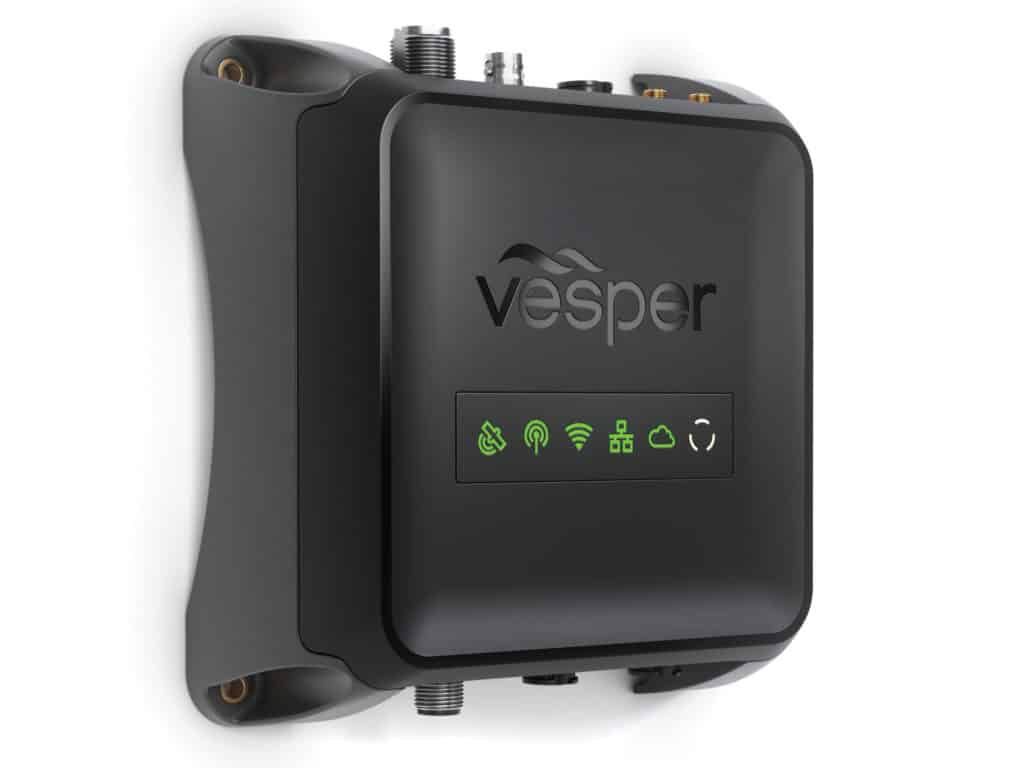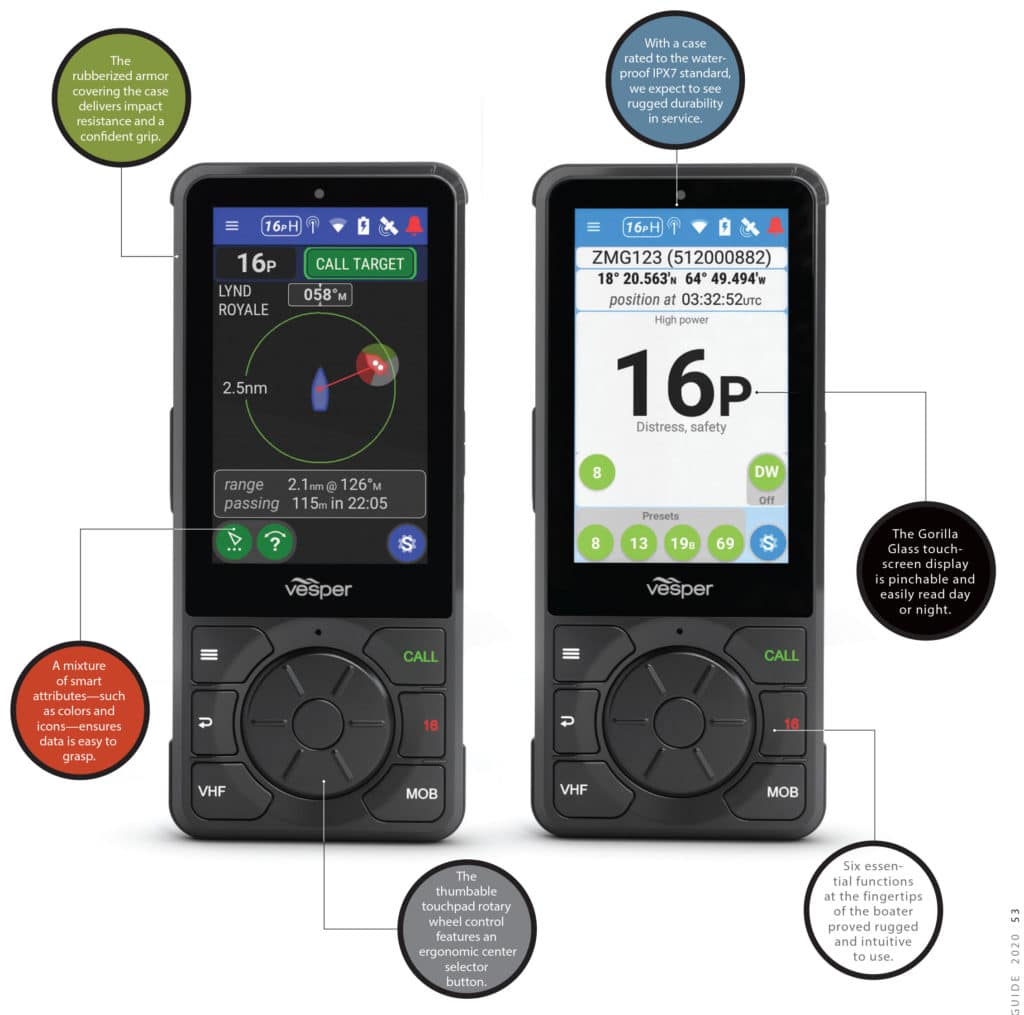
Delicately speaking, few pieces of mission-critical marine electronics equipment sport clunkier user interfaces than VHF radios. While there’s no question that they work exceptionally well, most VHFs still employ chunky analog knobs and push-buttons as their user interfaces, rather than -intuitive, app-based software and touchscreens.
This all changed with the arrival of Vesper Marine’s Cortex, a forward-thinking safety and communications platform that’s poised to revolutionize marine communications, alarms, and collision avoidance, both on and off the yacht.
If this sounds like a marinized iPhone, you’re on the right track, because Cortex delivers integrated, marine-specific communications in a similarly intuitive, software-driven device.
Also, like the iPhone, Cortex uses highly parallel multichannel architecture and a graphically rich, pinch-to-zoom touchscreen interface that declutters fidgety knobs, buttons, disparate screens, and proprietary operating systems. However, while outwardly simple, Cortex employs multiple pieces of hardware and software to accomplish its heady goal.
Hardware wise, Cortex is comprised of an IPX7-rated, black-box M1 processor and one or more optional-but-recommended H1 handsets, plus two smartphone apps. The M1, which is mounted to a belowdecks bulkhead, features a built-in AIS B/SO transponder, an embedded SIM card for cloud connectivity, and an integrated VHF splitter. It also has dual audio ports, a nine-axis sensor, a battery-voltage sensor, bilge-pump-sensor input, NMEA 0183/2000 connectivity, and two remotely commanded control outputs. All this comes in an industrial design with all-plastic construction.

Aesthetically, H1 handsets loosely resemble later-generation Apple iPods, with generously sized and optically bonded Gorilla Glass touchscreens and six hard buttons (menu, back, VHF, call, Channel 16 and man overboard) that flank a rotary wheel with a central selector; a dedicated DSC emergency button resides under a protective hood. The handsets are IPX7-rated, support one-handed operations (even with wet, salty gloves), and feature a rubberized treatment that absorbs impacts and delivers grip. (Note that while H1s can be wireless, each yacht’s first [and primary] H1 uses a hard‑wired power supply).
Wireless H1 handsets are optional and designed to remain aboard, so the system comes with two Android- and iOS-friendly apps. Cortex Onboard transforms a smartphone into a closely mirrored handset that delivers most of an H1’s functionality (except for VHF operations; users need an H1 handset to leverage Cortex’s VHF capabilities), while Cortex Monitor listens for activated onboard alarms while ashore.
Once networked with the yacht’s multifunction display (and/or NMEA backbone), GPS, VHF antenna and DC power (users can add cellular and Wi-Fi antennas), Cortex shares all communications passing through its M1 hub with its paired H1 handsets and Cortex Onboard, which render this information as easy-to-understand graphical depictions. Users can cycle between four operating views including VHF, directory (stored DSC contacts and favorites), instruments (NMEA data), and plotter; and the system includes three prioritized “situation views” for managing AIS targets, anchor-watch alarms, and man-overboard emergencies.
Unlike VHF and DSC-enabled VHF, Cortex handsets and the Cortex Onboard app allow users to directly call other AIS-equipped boats by simply tapping their onscreen icons. Likewise, users can easily hail their DSC contacts by tapping names in the directory.
“We tried to hide as many knobs and settings as possible,” Vesper Marine CEO Jeff Robbins says of Cortex’s approach to VHF operations.
Vesper ensured that updating Cortex’s software is a similarly streamlined process, thanks to Cortex’s paired connection with a user’s mobile device, which automatically serves as a data bridge.
Given that Vesper Marine earned its name as an AIS company, it’s not surprising that Cortex offers a further-developed version of the firm’s “smartAIS” concept, which uses smart-alarm logic to prioritize AIS targets and provide anchor-drag and MOB alarms. While smartAIS has been available for onboard use for years, Cortex smartly draws on its apps and its optional cloud-monitoring service to offer this same functionality onboard and ashore (or even from abroad). It also allows users to check their real-time shore power, battery levels, high-water, motion, and temperature information via the Cortex Monitor app. (Be aware that Cortex can be used without a subscription—however, such users are restricted to twice-a-day data updates.)
Should an alarm trip while users are aboard, and provided Cortex has been networked to an external speaker(s), the system delivers a series of intensifying audio alerts. Conveniently and much like Cortex’s situation views, the system’s voice guides users to their most-pressing concern(s), such as “MOB!”
While most yachtsmen aren’t satisfied using the same sounders or radars their fathers employed, thanks to Cortex, there’s also little reason to use communications interfaces that have largely existed since the dawn of the Clinton administration. So, if you’re ready to modernize your onboard communications and safety equipment, Cortex stands ready to help you communicate. •





